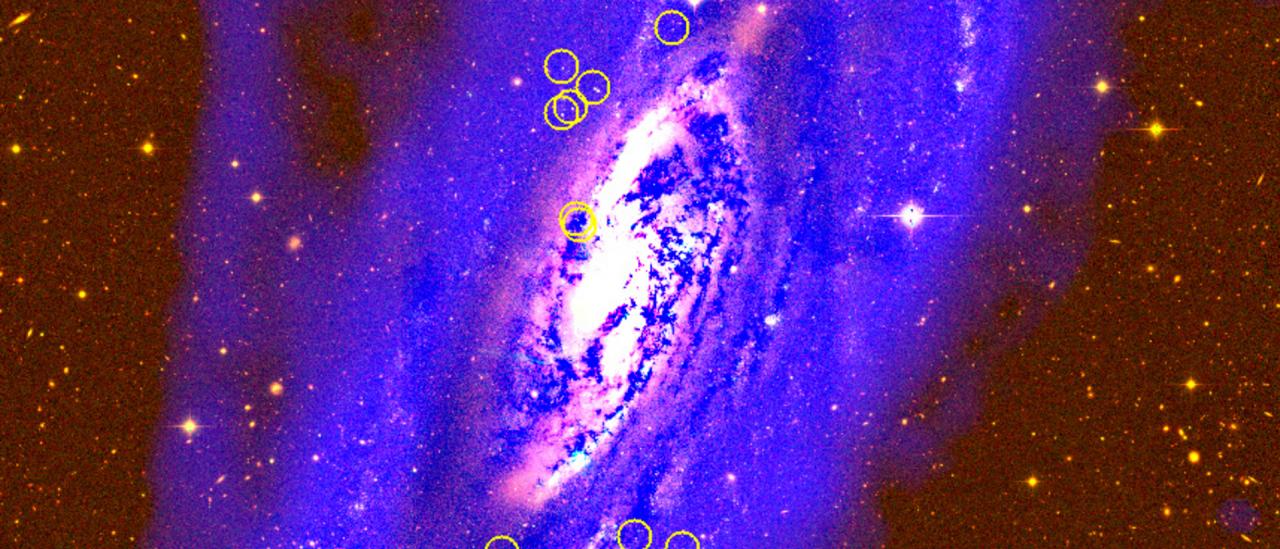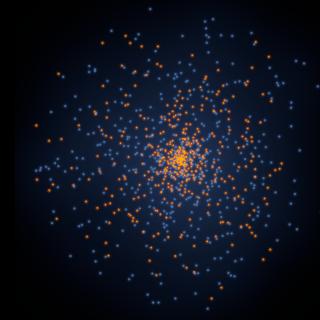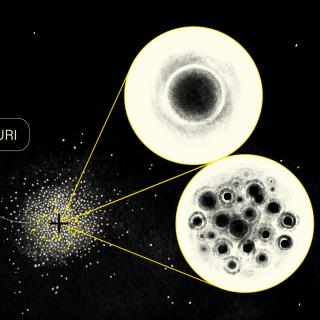An international study caried out with the OSIRIS instrument on the Gran Telescopio Canarias (GTC) has discovered, on the spiral galaxy Messier 106, a system of globular clusters whose unusual distribution and motion, aligned with the disc of the galaxy and rotating with the same velocity, shows that it could be a relic from the epoch of maximum star formation rate in the universe, the “cosmic noon”. The results are published in The Astrophysical Journal.
Globular clusters are clusters of between a hundred thousand and a million stars, whose components have all roughly the same age, and have similar chemical composition. They are very old objects, formed some 11,500 million years ago, 2.300 million years after the Big Bang. These clusters are normally found in large galaxies,distributed in their halos, in a spherical distribution around their centres.
An international piece of research, led by a group from the National Autonomous University of Mexico (UNAM) and carried out with the OSIRIS instrumen on the Gran Telescopio Canarias (GTC) has discovered in the spiral galaxy Messier 106 (also known as M106, and NGC 4258) globular clusters which, instead of being distributed in a sphere, appear to be arranged in a disc aligned with the disc of gas in the galaxy and rotating at approximately the same velocity at this disc.
“This has never been seen before, it is one of those totally unexpected and surprising findings which occur in science" explains Rosa Amelia González Lópezlira a researcher at the Instituto de Radioastronomía y Astrofísica (IRyA-UNAM), who has led this work. “The way these clusters move, and their distribution is similar to the discs of galaxies during the period of maximum star formation rate, some 10,000 million years ago, which is known as “cosmic noon”, so that we think that the disc of clusters in M106 could be a remnant from that epoch”
The power of the GTC and OSIRIS
The data obtained with the OSIRIS instrument, on tghe GTC at the Roque de los Muchachos Observatory have been of key importance, above all to confirm the candidates for globular clusters and to distinguish them from other apparent point sources such as stars, and distant galaxies. To do that one needs to take spectra to show that each cluster has a coeval population of old stars and really belongs to the galaxy under study,
For Divakara Mayya, a researcher at the Instituto Nacional de Astrofísica, Óptica y Electrónica (INAOE), the second author of the article “The observations with the GTC and OSIRIS are essential for the success of the study, because the objects are quite far away, and so they need exposures of more than one hour with the largest optical-infrared telescope in the world to be able to extract the relevant information from the spectra.
The OSIRIS instrument (Optical System for Imaging and low-Intermediate-Resolution Integrated Spectroscopy) is a multi-object spectrograph built at the Instituto de Astrofísica de Canarias (IAC) in collaboration with Mexico, which is capable of observing several objects at a time. “ To have this capacity for multiplexing, that is to obtain several spectra simultaneously, is fundamental for this type of studies, and it is offered on three of the current instruments on the GTC, covering the optical and the infrared” explains Antonio Cabrera, head of scientific operations on the GTC. For this work 23 candidate globular clusters in two fields were observed.
This article is one result from a wider project which will study the systems of globular clusters in nine spiral galaxies within a radius of 52 million light years, in order to look into the relation between the number of globular clusters and the mass of the central black hole in spiral galaxies “This relation if very tight for elliptical galaxies, but it is not so clear in spiral galaxies, such as the Milky Way,” comments researcher Lopezlira “The nine galaxies which we plan to study have good estimates of the masses of their central black holes, and lie at distances where we can make good studies of their globular clusters”
This recent study confirms that there is a correlation between the number of globular clusters and the mass of the central black hole in M106 and confirms the accuracy of the photometric method used at the GTC. “Studies of this type in more spiral galaxies can clarify the role of the different hypotheses proposed for galaxy assembly, and that of the globular clusters and central black holes” claims the first author of the article.
The Gran Telescopio Canarias and the Observatories of the Instituto de Astrofísica de Canarias (IAC) are a part of the network of Singular Scientific and Technical Infrastructures (ICTS) of Spain.
Article: González-Lópezlira, R. et al. "Spectroscopy of NGC 4258 Globular Cluster Candidates: Membership Confirmation and Kinematics", The Astrophysical Journal, Volume 876, Number 1. https://iopscience.iop.org/article/10.3847/1538-4357/ab113a/meta
Contact:
Rosa Amelia González Lópezlira, researcher of IRyA-UNAM, Mexico: r.gonzalez [at] irya.unam.mx (r[dot]gonzalez[at]irya[dot]unam[dot]mx)
Antonio Luis Cabrera Lavers, chief of scientifical operations of GTC: antonio.cabrera [at] gtc.iac.es (antonio[dot]cabrera[at]gtc[dot]iac[dot]es)



